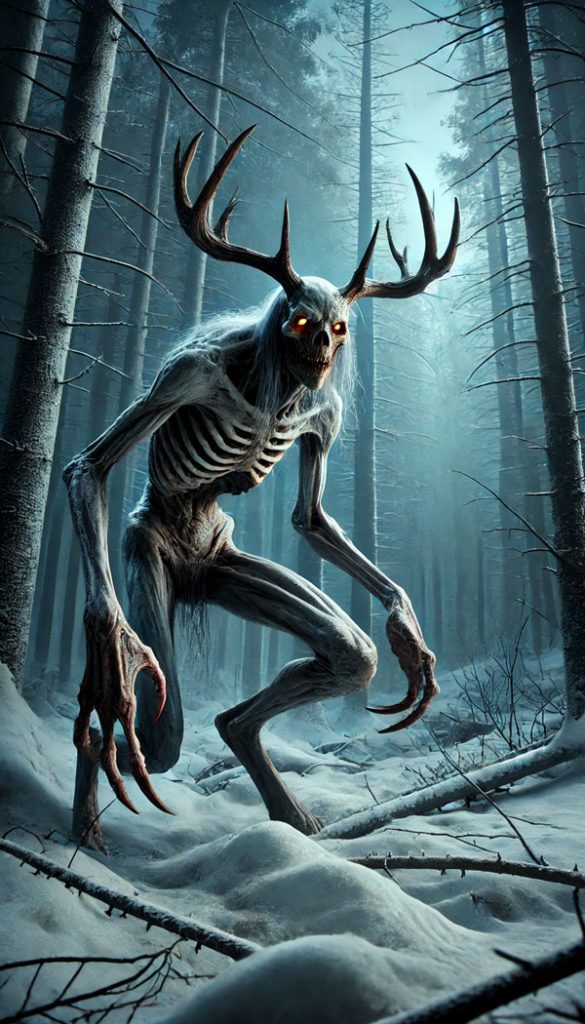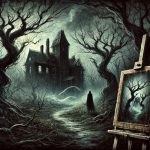
The Wendigo—a name that sends chills down the spine of anyone who has ever delved into the history of North American folklore. This malevolent spirit, deeply rooted in Algonquian tradition, is more than just a creature of legend. It’s a symbol of the darkest human impulses, a cautionary figure woven into the very fabric of winter and survival. As terrifying as it is fascinating, the Wendigo has found a powerful place in art, influencing artists from various disciplines to explore its sinister legacy.
The Origins of the Wendigo: A Glimpse into Algonquian Folklore
To understand the Wendigo’s impact on art, we first need to trace its roots. The Wendigo originates from the folklore of the Algonquian-speaking tribes, which include the Cree, Ojibwe, and Innu, among others. The Wendigo is often depicted as a malevolent spirit, embodying the dangers of greed and the cold, harsh realities of winter. In many tales, it is a creature driven by an insatiable hunger for human flesh, leading it to commit acts of cannibalism.
The Algonquian people believed that the Wendigo could possess individuals, turning them into monstrous beings with an endless appetite for destruction. This transformation was not just physical but also moral. The Wendigo symbolized the loss of humanity, the crossing of a line where a person becomes consumed by their darkest desires.
Artists have long been drawn to the Wendigo because of its powerful symbolism. It represents more than just a scary monster; it’s a reflection of human nature’s potential for evil. This duality—the combination of supernatural terror with real human fears—has made the Wendigo an enduring subject in various art forms.
The Wendigo in Visual Art: From Traditional Depictions to Modern Interpretations
Visual artists have been captivated by the Wendigo’s terrifying visage for centuries. Traditional depictions often show the creature as a gaunt, skeletal figure, its body emaciated and its eyes glowing with malevolence. These images draw directly from the descriptions found in Algonquian folklore, where the Wendigo is said to be a physical manifestation of starvation and winter’s cruelty.
One of the earliest known representations of the Wendigo in visual art comes from the rock paintings of the Algonquian tribes. These ancient artworks, etched onto the surfaces of cliffs and caves, show figures that resemble the Wendigo, with elongated limbs and sunken eyes. The purpose of these depictions was likely both spiritual and cautionary, serving as a reminder of the consequences of giving in to primal urges.
In more recent times, artists have reimagined the Wendigo in various ways. Some portray it as a creature with antlers, merging the humanoid figure with elements of the natural world. This fusion of human and animal features emphasizes the Wendigo’s role as a bridge between the natural and supernatural realms. Other artists have chosen to focus on the psychological aspect of the Wendigo, depicting it as a shadowy presence lurking in the background of more mundane scenes, symbolizing the hidden darkness within humanity.
These modern interpretations often highlight the Wendigo’s relevance in contemporary society. The creature’s association with greed, consumption, and the loss of humanity resonates with current concerns about environmental degradation and the consequences of unchecked capitalism. By placing the Wendigo in modern contexts, artists challenge viewers to consider how these ancient fears still apply today.
The Wendigo in Literature: A Symbol of Horror and Moral Decay
The Wendigo’s influence extends beyond visual art and into the realm of literature, where it has become a powerful symbol of horror and moral decay. One of the earliest literary references to the Wendigo comes from the writings of early European settlers and missionaries, who documented the tales of the Algonquian people. These accounts often portrayed the Wendigo as a demonic figure, emphasizing its association with cannibalism and the violation of social taboos.
In the 20th century, the Wendigo became a popular figure in horror literature. Algernon Blackwood’s 1910 short story “The Wendigo” is perhaps the most famous example. In this tale, Blackwood uses the Wendigo to explore themes of isolation, madness, and the primal fear of the unknown. The story’s setting in the Canadian wilderness—a place where the boundaries between civilization and nature blur—adds to the sense of dread, making the Wendigo a perfect embodiment of the terrifying forces that lurk just beyond the edge of human understanding.
Stephen King, one of the most prominent contemporary horror writers, also drew inspiration from the Wendigo in his novel Pet Sematary. Here, the Wendigo is not the central figure but a malevolent presence that haunts the burial ground, influencing the events that unfold. King’s use of the Wendigo underscores its role as a symbol of the unnatural, a force that disrupts the natural order and leads to horrifying consequences.
Literary depictions of the Wendigo often explore the creature’s symbolic connection to human behavior. The Wendigo’s insatiable hunger can be seen as a metaphor for greed, addiction, or the destructive consequences of giving in to one’s basest instincts. Through the lens of horror, writers use the Wendigo to delve into complex moral and psychological issues, making it a versatile and enduring figure in literature.
The Wendigo in Film and Television: A Cinematic Nightmare
The transition from literature to screen has only heightened the Wendigo’s terrifying allure. Filmmakers have embraced the creature’s chilling qualities, bringing it to life in a variety of ways. The Wendigo has appeared in numerous horror films and television shows, each interpretation adding a new layer to its mythos.
One of the most notable cinematic portrayals of the Wendigo can be found in the 1999 film Ravenous, directed by Antonia Bird. Set during the Mexican-American War, the film follows a group of soldiers who encounter the Wendigo’s spirit in the form of a fellow soldier turned cannibal. Ravenous uses the Wendigo legend to explore themes of survival, power, and the corrupting influence of hunger. The film’s dark humor and eerie atmosphere make it a unique take on the Wendigo myth, blending horror with a critical examination of human nature.
Television has also embraced the Wendigo, with the creature making appearances in popular shows like Supernatural and Hannibal. In Supernatural, the Wendigo is depicted as a monstrous predator stalking the woods, preying on unsuspecting campers. The show’s portrayal emphasizes the creature’s connection to wilderness and isolation, making it a formidable adversary for the protagonists. In Hannibal, the Wendigo is used more symbolically, representing the character Hannibal Lecter’s predatory nature and his manipulation of those around him. This more abstract interpretation shows the Wendigo’s versatility as a symbol, capable of representing a wide range of themes.
These cinematic and television portrayals often emphasize the Wendigo’s role as a creature of the wild, a being that embodies the fear of the unknown and the dangers that lie beyond the safety of civilization. The Wendigo’s connection to nature and its ability to blur the lines between human and monster make it a powerful symbol for exploring the darker aspects of the human psyche.
The Wendigo in Popular Culture: A Symbol of Modern Fears
Beyond the realms of fine art, literature, and film, the Wendigo has also made its mark on popular culture. The creature’s terrifying reputation has led to its inclusion in video games, comic books, and even internet memes, where it continues to capture the imaginations of audiences.
In the world of video games, the Wendigo has appeared as a fearsome enemy in titles like Until Dawn and Wendigo: The Evil That Devours. These games capitalize on the creature’s horrifying attributes, using its emaciated form and predatory nature to create intense, suspenseful experiences for players. The Wendigo’s presence in these games often serves as a reminder of the dangers of isolation and the primal fears that arise when one is cut off from society.
Comic books have also embraced the Wendigo, with the creature appearing in various storylines, including those in the Marvel Universe. In Marvel comics, the Wendigo is a cursed being, transformed by consuming human flesh in the Canadian wilderness. This version of the Wendigo is often depicted as a tragic figure, driven by a curse rather than pure malevolence. The Wendigo’s appearances in comic books highlight its adaptability as a character, capable of fitting into different narratives and genres.
The internet has also played a significant role in keeping the Wendigo legend alive. The creature has become a popular subject for “creepypasta” stories—short horror tales shared online. These modern urban legends often reinterpret the Wendigo in new and creative ways, blending traditional folklore with contemporary fears. The Wendigo’s presence in internet culture shows its continued relevance as a symbol of horror, capable of evolving to meet the anxieties of each new generation.
The Psychological Impact of the Wendigo: Exploring Its Symbolism
Why does the Wendigo continue to fascinate us? What is it about this creature that resonates so deeply with audiences across different media? To answer these questions, we need to delve into the psychological impact of the Wendigo and the symbolism it carries.
At its core, the Wendigo represents the fear of losing control—of succumbing to our darkest impulses and becoming something monstrous. This fear is universal, transcending cultural boundaries and historical periods. The Wendigo’s association with cannibalism and winter adds another layer to this symbolism, tying it to themes of survival, desperation, and the thin line between civilization and savagery.
The Wendigo’s emaciated form also speaks to the fear of scarcity and the consequences of unchecked consumption. In a world where resources are finite, the Wendigo serves as a reminder of what can happen when we take more than we need. This symbolism is particularly relevant in today’s society, where concerns about environmental degradation and sustainability are at the forefront of many people’s minds.
The Wendigo’s ability to possess individuals adds a psychological dimension to its horror. It is not just a creature that exists outside of us; it is something that can take root within us, transforming us from the inside out. This aspect of the Wendigo legend touches on fears of mental illness, addiction, and the loss of self-control. By exploring these fears through the lens of the Wendigo, artists and storytellers can tap into deep-seated anxieties that resonate with audiences on a primal level.
The Wendigo as a Cultural Mirror: Reflecting Societal Anxieties
Throughout its history, the Wendigo has served as a cultural mirror, reflecting the anxieties and fears of the societies that tell its story. In its earliest forms, the Wendigo was a warning against the dangers of greed and the consequences of breaking social taboos. As the legend evolved, it became a symbol of the fear of the unknown, the wilderness, and the loss of humanity.
In contemporary times, the Wendigo has taken on new meanings. It has become a symbol of the consequences of environmental destruction, the dangers of unchecked capitalism, and the psychological toll of modern life. The Wendigo’s adaptability as a symbol makes it a powerful tool for exploring the complex issues that define our era.
The Wendigo’s role as a cultural mirror is evident in the way it has been portrayed in different media. In literature, it is often a symbol of moral decay and the loss of self. In film and television, it represents the fear of the unknown and the dangers of isolation. In popular culture, it has become a figure of modern horror, embodying the anxieties of the digital age.
This ability to reflect societal anxieties is what keeps the Wendigo relevant. As long as we have fears to explore and taboos to confront, the Wendigo will remain a potent symbol in our collective imagination.
The Enduring Legacy of the Wendigo in Art and Culture
The Wendigo’s journey from Algonquian folklore to its place in modern art and culture is a testament to its enduring power as a symbol of horror and moral caution. Whether depicted as a monstrous creature or a psychological presence, the Wendigo continues to captivate and terrify audiences across the globe.
Its influence can be seen in visual art, where artists explore the creature’s symbolic connections to nature, greed, and the loss of humanity. In literature, the Wendigo serves as a powerful metaphor for moral decay and the dangers of giving in to one’s darkest impulses. In film and television, it represents the primal fears that arise from isolation and the unknown. And in popular culture, the Wendigo has become a versatile figure, capable of adapting to the anxieties of each new generation.
As we move further into the 21st century, the Wendigo’s legacy shows no signs of fading. Its ability to evoke fear, provoke thought, and reflect societal anxieties ensures that it will remain a fixture in art and culture for years to come. The Wendigo is more than just a creature of legend; it is a symbol of the human condition, a reminder of the thin line between civilization and savagery, and a cautionary tale that continues to resonate with audiences around the world.
Conclusion
The Wendigo’s influence in art and culture is a testament to the power of folklore to transcend time and place. From its origins in Algonquian legend to its modern interpretations in various media, the Wendigo remains a potent symbol of horror, moral decay, and the dangers that lurk in the shadows of human nature. As long as artists and storytellers continue to explore these themes, the Wendigo will endure as a figure of both terror and fascination, reflecting our deepest fears and darkest desires.




